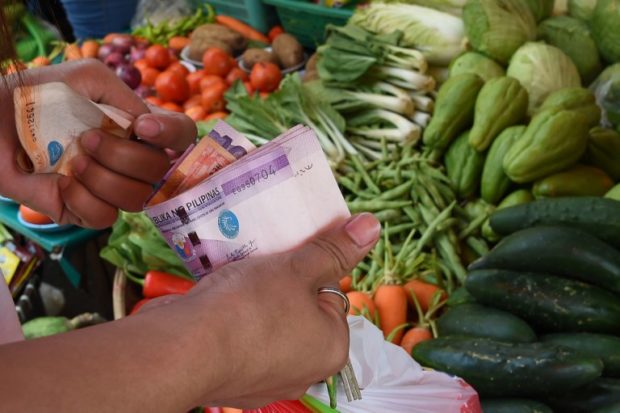
A customer buys vegetables at a market in Manila on October 5, 2018. – Philippine inflation has risen for a ninth straight month in September, to a near-10-year high, the government said October 5, in an unexpected challenge for President Rodrigo Duterte. (Photo by TED ALJIBE / AFP)
BSP survey: Economic worries strain business, consumer confidence for Q3
MANILA, Philippines — Inflation likely breached 6 percent in June, adding pressure on the Bangko Sentral ng Pilipinas (BSP) to hike interest rates more aggressively, economists said.
Of the 16 June inflation forecasts collected by the Inquirer last week, 10 were above 6 percent, and all were higher than the BSP’s projected full-year average of 5 percent. The last time that headline inflation hit the 6-percent mark was the 6.1-percent rate in November 2018, at the height of the rice crisis, which led to import liberalization.
The government will report on last month’s inflation rate on Tuesday.
Goldman Sachs Economics Research, HSBC Global Research, and Bank of the Philippine Islands’ Emilio Neri Jr. had the highest forecast of 6.1 percent. Neri attributed his projection to “higher power, petroleum prices and a weaker peso, which likely outweighed the decline in fish and LPG prices.” The peso crossed the 55:$1 mark before last month ended.
Neri said consumers should brace for more upward inflationary pressures this month on the back of fare and wage hikes.
“Although the government already extended the lower tariff rates for pork, rice, corn and coal, this might not be enough to offset the rising prices in fuel and transport,” HSBC said.
China Bank’s Domini Velasquez, DBS’s Han Teng Chua, ING’s Nicholas Antonio Mapa, Rizal Commercial Banking Corp.’s Michael Ricafort, Security Bank’s Robert Dan Roces, Standard Chartered’s Jonathan Koh and UnionBank of the Philippines’ Ruben Carlo Asuncion forecast 6-percent inflation in June.
“The government’s initial response to domestic shortages in food supply—by importing more key food items such as meat, fish and corn—is now at risk with higher food prices worldwide and a weaker peso. Hence, we think inflation has not yet peaked and will continue its climb as producers continue to pass on their higher costs to consumers,” Velasquez said.
Economic recovery
“The robust economic recovery is likely to lead to a further increase in pass-through of prices,” Koh said.
For Mapa, “price pressures are largely supply-side driven (land war in Europe and supply chain disruptions), but it is almost impossible to discount the emergence of demand-side pressures.”
“Malls are packed, restaurants are full and traffic is back to pre-COVID-19 levels, showing that consumers are still adamant about spending even in the face of multi-year inflation,” Mapa said.
Asuncion said “a higher-than-expected inflation print this June puts the BSP on a tighter place that needs to see a higher-than-expected rate hike by August.” The BSP already hiked the policy rate twice in a row with a cumulative 50 basis points to 2.5 percent, although some analysts deemed the Monetary Board to be behind the curve compared to supersized rate increases by the US Federal Reserve and other central banks.
The minority of forecasters estimated below 6 percent: e-Methods for Business Management Corp.’s Jonathan Ravelas, Moody’s Analytics’ Sonia Zhu and Regina Capital’s Luis Gerardo Limlingan, 5.8 percent; Philippine National Bank’s Alvin Joseph Arogo and Pantheon Macroeconomics’ Miguel Chanco, 5.7 percent; and Capital Economics’ Gareth Leather, the lowest at 5.4 percent.
Chanco shared Mapa’s view that the inflation spike during the past three months likely “did not have an impact on second-quarter gross domestic product growth and beyond.”
But for Zhu, “entrenched inflation squeezes household income will limit domestic consumption, putting a cap on real economic growth.” Zhu cited that the Philippines was currently struggling with among the highest inflation rates in Asia-Pacific.
RELATED STORIES
Tight food supply by year-end to worsen inflation
PSEi dives as inflation concerns welcome Bongbong Marcos
La Niña seen worsening inflation woes in PH

